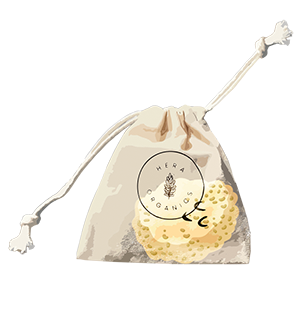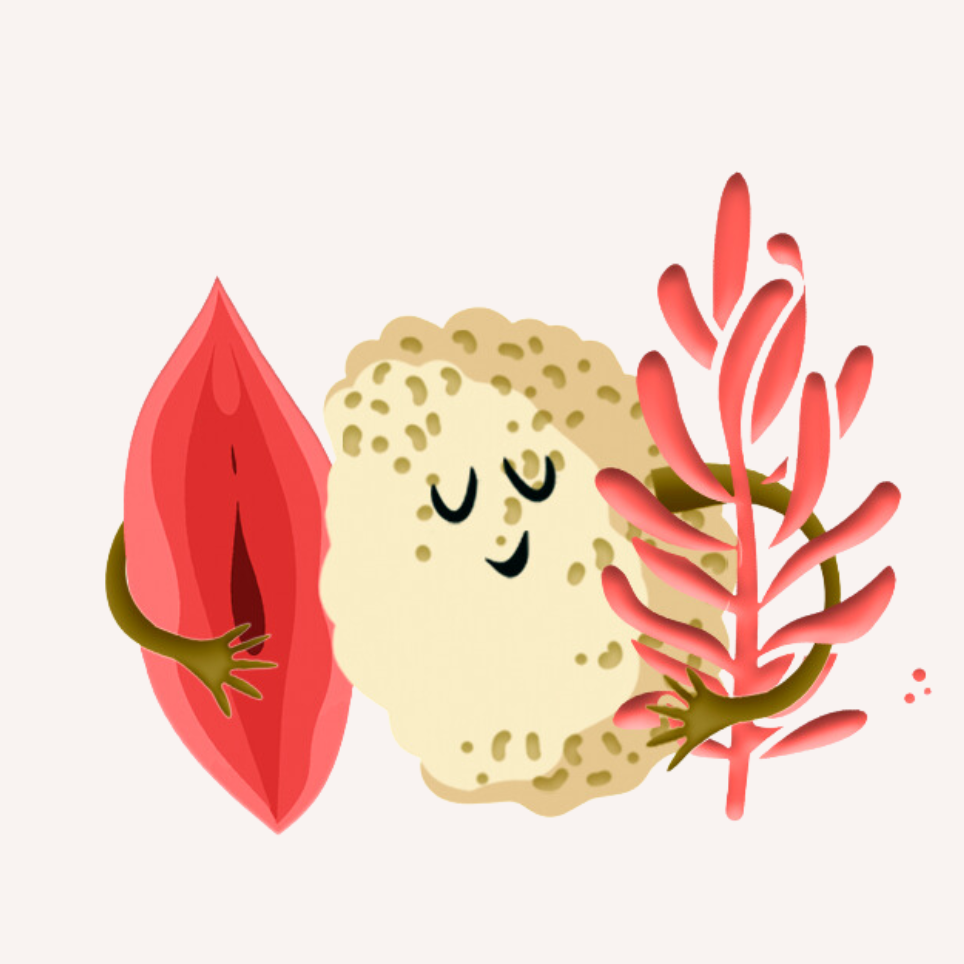Allgemeine Fragen:
Wie viel bezahle ich für den Versand?
Wie viel bezahle ich für den Versand?
Der Versand ist in der Schweiz, Liechtenstein und Deutschland kostenlos!
Wie lange dauert die Lieferung?
Wie lange dauert die Lieferung?
Wir liefern dir die Menstruationsschwämmchen innerhalb von 2-3 Werktagen zu dir nach Hause!
Alle Fragen zur Anwendung der Schwämme:
Wie führe ich den Menstruationsschwamm am besten ein?
Wie führe ich den Menstruationsschwamm am besten ein?
1. Nachdem du deine Hände gründlich gewaschen hast, befeuchte den Schwamm unter fließendem Wasser und drücke ihn mit deinen Händen aus, bis kaum noch Flüssigkeit im Schwamm vorhanden ist.
2. Drücke den Schwamm mit dem Pinzettengriff bzw. zwei Fingern (mit Daumen und Zeigefinger oder Mittelfinger) zusammen.
3. Führe ihn langsam und zusammengedrückt in die Scheide ein. Höre dabei auf deinen Körper und platziere den Schwamm dort, wo es sich für dich am Besten anfühlt. Der Menstruationsschwamm muss jedoch nicht so tief wie ein Tampon im Körper platziert werden.
Pro-Tipp: Bei größeren Perioden Schwämmen kannst du die beiden "Enden" der Schwämme in entgegengesetzte Richtungen zusammendrehen und einführen. Dabei entfernst du gewissenhaft jegliche Flüssigkeiten aus dem Schwamm und gleichzeitig nimmt dieser die längliche Form eines Tampons an, was dir das Einführen nochmals erleichtern kann.
In welcher Position führe ich den Menstruationsschwamm ein und entferne ihn wieder?
In welcher Position führe ich den Menstruationsschwamm ein und entferne ihn wieder?
Wir empfehlen dir diese 3 Positionen:
1. In der Hocke
2. Ein Bein hoch (Zum Beispiel auf die Toilette oder Badewanne)
3. Skispringer Position
Ist der Schwamm geruchsneutral?
Ist der Schwamm geruchsneutral?
Der Schwamm ist geruchsneutral und die enthaltenen Enzyme und Mineralien hemmen die Entwicklung von Gerüchen sowie die Entstehung von Pilzen und Bakterien. Herkömmliche Menstruationsprodukte wie Tampons und Binden enthalten dabei Toxine, die den natürlichen pH-Wert erhöhen können und somit das Wachstum von Bakterien und unangenehme Gerüche fördern. Das natürliche Material der Menstruationsschwämme unterstützt deine Scheidenflora und sorgt für einen gesunden pH-Wert.
Solltest du trotzdem mal einen unangenehmen Duft wahrnehmen, wasche deinen Schwamm zuerst mit Wasser aus und lege ihn anschließend für 2-3 Stunden in eine milde Essig-Wasser-Lösung.
Als zweite Option kannst du das Schwämmchen in ein Glas Wasser legen und 1-2 Tropfen Teebaumöl dazugeben (anschließend gründlich auswaschen!) Teebaumöl wirkt zusätzlich antibakteriell, aber sollte nicht zu oft verwendet werden.
Wie lasse ich die Menstruationsschwämme trocknen?
Wie lasse ich die Menstruationsschwämme trocknen?
Es ist sehr wichtig, dass du die Menstruationsschwämme nach der Reinigung, sei es während oder nach deiner Periode, an einem trockenen Ort an der Luft komplett trocknen lässt. Wir empfehlen den Schwamm nicht im Badezimmer zu trocknen aufgrund der erhöhten Feuchtigkeit. Sofern du sichergestellt hast, dass die Menstruationsschwämme 100% trocken sind, verstaue sie in unserem luftdurchlässigen Hygienebeutel und nicht an einem Ort, der keinen Sauerstoff zulässt, wie zum Beispiel in der Versandboxen.
Kann der Schwamm im Körper verloren gehen?
Kann der Schwamm im Körper verloren gehen?
Nein - Mache Dir keine Sorgen! Der Schwamm kann niemals in deinem Körper verloren gehen oder in deine Gebärmutter gelangen! Der Gebärmuttermund ist bei nicht schwangeren Frauen viel zu klein für den Schwamm. Zudem rutscht der Schwamm automatisch ein Stück nach unten, sobald er mit Blut voll ist. Kannst du ihn immer noch nicht greifen, so übe Druck auf deinen Beckenbodenmuskel aus für eine noch einfachere Entfernung. Wichtig ist, dass du dich nicht verkrampfst und Ruhe bewahrst. Lass dir bei der Entfernung Zeit und für maximale Entspannung kannst du zum Beispiel auch ein Bad nehmen. Dadurch saugt sich der Schwamm leicht mit Wasser auf und kann weiter nach unten rutschen.
Beachte bitte die maximal empfohlene Tragedauer von 8 Stunden. Weitere Informationen zum TSS (Toxic Shock Syndrom) findest du im FAQ oder in unserer Packungsbeilage.
Hinweise zum TSS
Hinweise zum TSS
Das toxische Schocksyndrom tritt selten auf, ist jedoch eine ernstzunehmende Krankheit, bei der schädliche Bakterien in den Blutkreislauf eindringen und Giftstoffe freisetzen. TSS kann bei allen Perioden Produkten eintreten.
Wir empfehlen folgende Schritte, um das TSS-Risiko zu reduzieren:
- Reinige die Schwämme jeweils vor deiner Periode mit der Essig-Wasser Lösung (Verhältnis 1:2) über Nacht und wasche und drücke sie danach mit Wasser gründlich aus. Dieses Verfahren kann auch während deiner Periode erneut durchgeführt werden.
- Benutze keine in die Scheide eingeführten Hygieneartikel oder Empfängnisverhütungsmittel einschließlich dem HERA organics Menstruationsschwamm, wenn du schon einmal TSS hattest.
- Vergiss nicht, deinen Menstruationsschwamm idealerweise nach 3-5 Stunden aber maximal nach 7 Stunden zu entnehmen und zu reinigen. Danach kannst du ihn wieder einsetzen.
- Wasch dir deine Hände gründlich, bevor und nachdem du deine den Menstruationsschwamm benutzt.
Die Symptome von TSS sind häufig einer Grippe ähnlich. Dazu gehören:
- Plötzliches hohes Fieber
- Erbrechen
- Durchfall
- Schwindel
- Ohnmacht
- Sonnenbrandartige Hautrötung während oder einige Tage nach der Regel
Bitte kontaktiere bei Symptomen sofort einen Arzt.
Dein Schwamm Lexikon:
Was ist ein Menstruationsschwamm?
Was ist ein Menstruationsschwamm?
Die Schwämme gehört zu den vielzelligen Organismen aus dem Meer. Schwämme bestehen aus feinen, wasserdurchlässigen Poren und weltweit gibt es über 10'000 Arten. Sie haben kein Gehirn, keine Nervenzellen, keine Organe, keine Muskeln aber sie haben Eigenschaften die vielen Menschen helfen können zum Beispiel auch in der Medizin. Schwämme gibt es schon seit Hunderten von Millionen Jahren und kommen in vielen Bereichen zum Einsatz.
Ist der Menstruationsschwamm vegan?
Ist der Menstruationsschwamm vegan?
Beim Schwamm handelt es sich um einen aquatischen Organismus. Biologisch gesehen, handelt es sich streng genommen nicht um eine Pflanze, sondern er fällt unter die Kategorie des Vielzellers. Der Schwamm hat kein Gehirn, keine Organe, kein Kreislauf- oder Zentralnervensystem und damit auch keine Muskel- und Sinneszellen. Zudem wird bei der Ernte nicht der gesamte Schwamm gepflückt, sondern blosse Teile davon, um einen nachhaltigen Abbau zu gewährleisten. Der Schwamm kann sich zudem asexuell reproduzieren, indem Knospen am Schwamm wachsen, welche durch diesen abgeschnürt werden.
Viele Veganer betrachten den Schwamm als vegan-freundlich, trotz der Einordnung als Tier, denn der Schwamm lebt, wächst und reproduziert sich ähnlich wie eine Pflanze.
Wie wird der Schwamm geerntet?
Wie wird der Schwamm geerntet?
Die Menstruationsschwämme von HERA Organics stammen aus einem griechischen Familienbetrieb in dritter Generation. Diese natürlich vorkommenden Meereschwämme werden von ausgewählten Tauchern im Mittelmeer in Tiefen von 50-100 Metern nachhaltig geerntet. Um die Regeneration zu unterstützen, wird stets nur ein Teil des Schwammes entnommen, sodass er innerhalb weniger Monate nachwachsen kann. Dabei wird strikt auf Erntepausen geachtet, um die natürlichen Bestände zu schützen und das marine Ökosystem nicht zu beeinträchtigen.
Nach ihrer Ernte werden die Schwämme gründlich gereinigt, wobei ihre natürliche Beschaffenheit erhalten bleibt. Vor Gebrauch sollte stets darauf geachtet werden, die Hände sorgfältig zu waschen.
Seit wann gibt es Menstruationsschwämme?
Seit wann gibt es Menstruationsschwämme?
Menstruationsschwämme sind die Ur-Tampons aller Tampons und werden seit der Antike verwendet.



